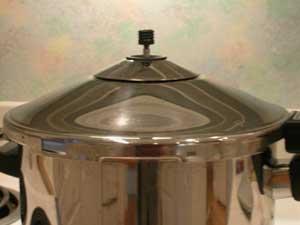 After the white blossoms wither, the greens beans come in hard and fast. I go over the bean beds every day or two, always finding slim green seed pods ripe for picking.
After the white blossoms wither, the greens beans come in hard and fast. I go over the bean beds every day or two, always finding slim green seed pods ripe for picking.The first rush of beans are always the easiest to pick; they perch at the top of the plants, flaunting their little bean selves in the sun. "Look at me!" they shout. "I'm a full grown green bean!" And then I end their beany pride with a single snap of the stem.
It's all right, though. I rarely mourn for guillotined beans. They taste too good. Especially the first "mess" of the year. Cooked to tender perfection in the pressure cooker. A pressure cooker? Hey, it worked for my mother, it works for me.
Pressure cookers have fallen out of favor these days. Their claim to fame – cooking food faster – has been quashed by microwave efficiency. My friends shudder at the thought of pressure cookers blowing their emergency valves, spewing hot food up to the ceiling. I just smile. They don't know what they're missing.
My old aluminum Mirro twins- a four quart for small loads and a six quart that would handle canning jars – have been my heavy artillery since I was a young bride back in the early '70s. I'd load up my Mirros, put in the rubber gasket to ensure a tight fit, plop the weight on top of the pointy pressure valve and wait for the unmistakeable jiggle that let me know when the steam was working its magic on whatever was sealed inside the pan.
The pressure cooker could put a pot roast on fast forward so dinner would be on time, even if I forgot to thaw. It was an ace at veggies: corn on the cob, fresh beets, green beans (with a little bacon grease for extra flavor).
Last summer, I replaced the Mirros with an upscale stainless steel cooker made in Switzerland. The new model has no weights or steamy jiggle. Instead, a small black knob rises sedately to reveal two red marks. The red marks indicate that the food inside is cooking and the timing can begin. Six minutes for green beans.
It was an odd adjustment; I found myself listening for the jiggle to reassure me that something was happening underneath the lid. But the black valve is silent. Almost stealthy.
Which is exactly the reason I burned an entire batch of beans last week. For 30 years, I have depended on the weight jiggling to alert me. Danger. Beans are cooking. Get in here and turn down the heat.
I'm a quick study. I set the timer for the next mess of beans. They are too precious to waste, either by leaving them in the garden to turn big and bumpy or to burn them in the "improved" pressure cooker. I miss my Mirro. But I still love my pressre cooked green beans.
Time to plant another succession crop. Gotta have 'em all summer long!